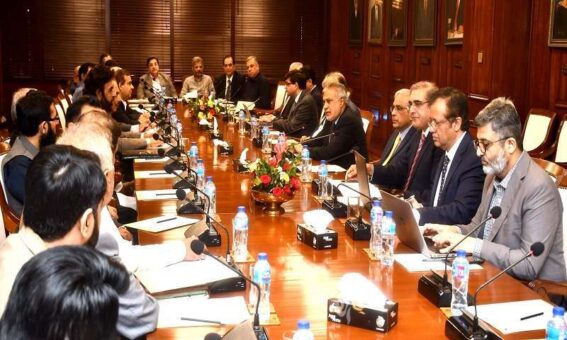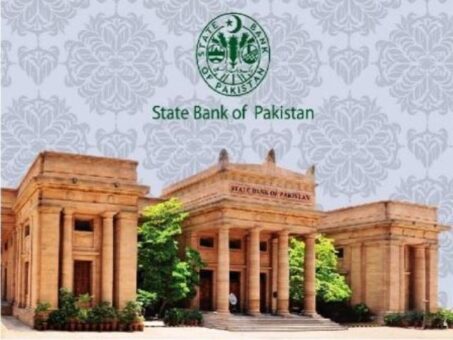KARACHI, November 02, 2022 – The State Bank of Pakistan (SBP) has released the foreign exchange rates for November 02, 2022.
(more…)Tag: SBP
-

Karachi Interbank Offered Rates KIBOR – November 01, 2022
KARACHI: State Bank of Pakistan (SBP) on Tuesday issued the Karachi Interbank Offered Rates (KIBOR) as on November 01, 2022.
Following are the latest KIBOR rates:
Tenor BID OFFER 1 – Week 14.97 15.47 2 – Week 15.01 15.51 1 – Month 15.07 15.57 3 – Month 15.52 15.77 6 – Month 15.60 15.85 9 – Month 15.61 16.11 1 – Year 15.63 16.13 READ MORE: Karachi Interbank Offered Rates KIBOR – October 31, 2022
-

State Bank issues foreign exchange rates on November 01, 2022
KARACHI, November 01, 2022 – The State Bank of Pakistan (SBP) has unveiled the foreign exchange rates for November 01, 2022.
(more…) -

Karachi Interbank Offered Rates KIBOR – October 31, 2022
KARACHI: State Bank of Pakistan (SBP) on Monday issued the Karachi Interbank Offered Rates (KIBOR) as on October 31, 2022.
Following are the latest KIBOR rates:
Tenor BID OFFER 1 – Week 14.94 15.44 2 – Week 14.99 15.49 1 – Month 15.06 15.56 3 – Month 15.51 15.76 6 – Month 15.59 15.84 9 – Month 15.61 16.11 1 – Year 15.63 16.13 READ MORE: Karachi Interbank Offered Rates KIBOR – October 28, 2022
-

State Bank issues foreign exchange rates on October 31, 2022
KARACHI – In a routine update, the State Bank of Pakistan (SBP) released the foreign exchange rates for October 31, 2022. The rates are determined based on the weighted average rates of commercial banks operating in the country.
(more…) -

Dar advises forex companies to ensure appropriate exchange rate
ISLAMABAD: Finance Minister Ishaq Dar has advised foreign exchange companies to ensure appropriate exchange rate for the betterment of the country.
Federal Minister Senator Mohammad Ishaq Dar held a meeting with heads of all the major Forex Exchange Companies of Pakistan at state Bank of Pakistan (SBP).
READ MORE: Meezan Bank donates Rs35 mn to Indus Hospital for power project
Senior Advisor to Prime Minister (SAPM) on Finance Tariq Bajwa, SAPM on Revenue Tariq Pasha, Governor SBP Jameel Ahmad and senior officers from Finance Division and State Bank of Pakistan attended the meeting.
The Finance Minister highlighting the economic situation of the country stated that the present government with its pragmatic policy decisions has not only arrested the decline but has also set the economy in the right direction.
READ MORE: NdcTech wins best sales partner award
Finance Minister also shared the priorities of the present government and expressed resolve of the Government to ensure stable economic and fiscal policies and requested the forex companies to ensure appropriate exchange rate for the betterment of the country.
READ MORE: Rupee crashes to dollar as PTI long march starts
The leading Exchange companies of Pakistan showed complete trust in Government’s fiscal and monetary policies and committed to the Finance Minister their full support to ensure economic and financial strengthening of Pakistan.
READ MORE: SBP imposes over Rs290 million as penalty on six commercial banks
-

SBP imposes over Rs290 million as penalty on six commercial banks
KARACHI: State Bank of Pakistan (SBP) on Friday imposed over Rs290 million as monetary penalty on six commercial banks for violating regulatory instructions pertaining to Customer Due Diligence (CDD) and Know Your Customer (KYC) during quarter ended September 30, 2022.
The central bank imposed the monetary penalty on commercial banks included: Bank Al Habib Limited; Meezan Bank Limited; National Bank of Pakistan; MCB Bank Limited; JS Bank Limited; and Faysal Bank Limited.
The highest amount of penalty of Rs140.03 million has been imposed on Bank Al Habib Limited for violating regulatory instructions pertaining to CDD/KYC, Asset Quality, Foreign Exchange and general banking operations.
The SBP directed Bank Al Habib Limited that besides payment of monetary penalty it should strengthen its control/process in the identified areas.
The second highest penalty of Rs81.72 million has been imposed on Meezan Bank Limited for the same regulatory violations. The SBP also imposed penalties, included: Rs25.875 million on National Bank of Pakistan; Rs19.223 million on MCB Bank Limited; Rs13.49 million on JS Bank Limited; and Rs10.025 million on Faysal Bank Limited.
The SBP from July 2019 started public disclosure of penal action against banks. “Enforcement actions are an integral part of the regulatory regime which involves imposition of monetary penalties and other actions against institutions and individuals for violations of laws, rules, regulations, guidelines or directives issued by SBP from time to time,” according to a circular issued by the central bank.
In order to bring more transparency and strengthen market discipline, SBP has decided to publicly disclose significant enforcement actions.
-

Karachi Interbank Offered Rates KIBOR – October 28, 2022
KARACHI: State Bank of Pakistan (SBP) on Friday issued the Karachi Interbank Offered Rates (KIBOR) as on October 28, 2022.
Following are the latest KIBOR rates:
Tenor BID OFFER 1 – Week 14.85 15.35 2 – Week 14.93 15.43 1 – Month 15.04 15.54 3 – Month 15.51 15.76 6 – Month 15.58 15.83 9 – Month 15.59 16.09 1 – Year 15.61 16.11 READ MORE: Karachi Interbank Offered Rates KIBOR – October 27, 2022
-

State Bank issues foreign exchange rates on October 28, 2022
KARACHI – The State Bank of Pakistan (SBP) has released the foreign exchange rates for October 28, 2022, reflecting the value of the Pakistani Rupee (PKR) against various major currencies.
(more…) -

SBP’s weekly forex reserves dip by $157 million to $7.44 billion
KARACHI: The official weekly foreign exchange reserves of the State Bank of Pakistan (SBP) fell by $157 million to $7.44 billion by week ended October 21, 2022, the central bank said on Thursday.
The official foreign exchange reserves of the SBP were at $7.597 billion a week ago i.e. October 14, 2022.
READ MORE: Pakistan’s weekly forex reserves increase nominally
The central bank attributed the decline to external debt repayments.
SBP however said it h ad received $1.5 billion from Asian Development Bank (ADB) in value on October 26, 2022 as disbursement of loan for the Government of Pakistan. These proceeds will be reflected in SBP reserves for the week ending October 28, 2022.
READ MORE: Pakistan’s forex reserves continue to fall; deplete to $13.25 billion
The foreign exchange reserves held by the central bank witnessed a record high at $20.146 billion by week ended August 27, 2021. Since then the official reserves of the SBP dropped by $12.706 billion.
Previously, the central bank received $1.16 billion from the International Monetary Fund (IMF) under Extended Fund Facility (EFF) program, which increased the official reserves to $8.8 billion. But scheduled repayment gradually depleted the official reserves of the central bank.
READ MORE: Pakistan’s forex reserves decline to $13.59 billion
The total foreign exchange reserves of the country fell by $89 million to $13.162 billion by week ended October 21, 2022 as compared with $13.251 billion a week ago.
The country’s foreign exchange reserves hit all-time high of $27.228 billion on August 27, 2021. Since then the foreign exchange reserves have declined by $14.066 billion.
The foreign exchange held by commercial banks witnessed an increase of $68 million to $5.722 billion by week ended October 21, 2022 as against $5.654 billion a week ago.